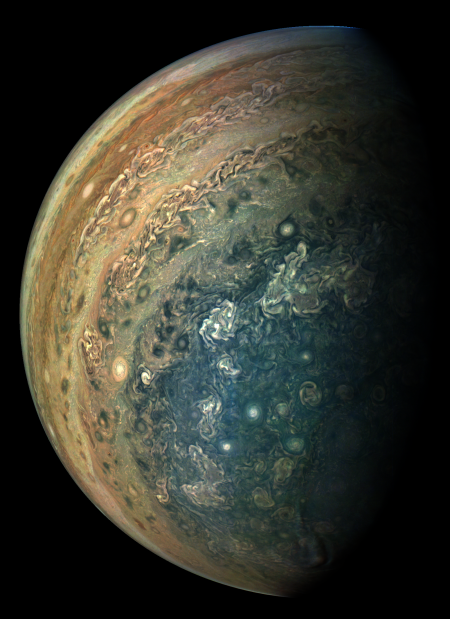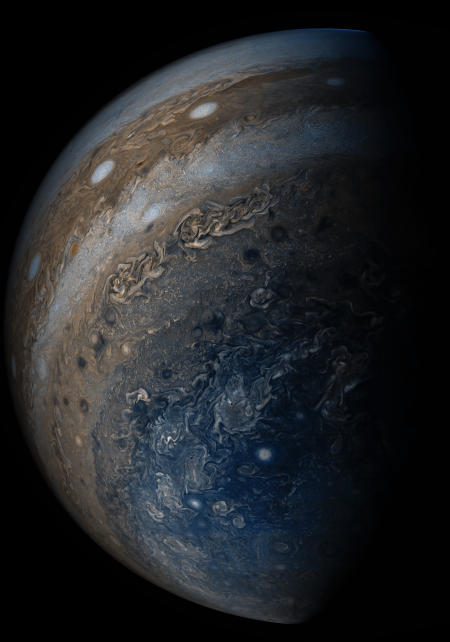Juno images processed by citizens highlighted at conference
Several Juno images that have been cleverly processed by citizen scientists are being highlighted at a Jupiter conference being held in London this week.
JunoCam images presented at the meeting by citizen scientists Gerald Eichstädt and Seán Doran include an animation showing the evolution of swirling features in the giant planet’s atmosphere and a composite image of Jupiter’s cloud tops.
Gerald Eichstädt, a mathematician working as a software professional, has taken two images from JunoCam and reprojected them to the same vantage point to enable a direct comparison between the images and show the subtle motions within the atmosphere. By modelling the movement of individual pixels in the images, he has created an animation that extrapolates the swirling evolution of the vortices in the atmosphere.
Eichstädt explains: “This animation represents a ‘feasibility test’. Building on this initial work, we can add in more variables that will give us a more detailed description and physical understanding of Jupiter’s atmosphere.”
Seán Doran, in collaboration with Eichstädt, has created a new composite image of Jupiter as seen by Juno as it swung away from Jupiter’s south pole on 1st April 2018. Because Jupiter was larger than JunoCam’s field of view when the main portion of the image was taken, Eichstädt rendered four other images to the same viewing geometry to reconstruct a mosaic of the whole planet. Doran then processed the composite image to balance and blend the overlapping components, sharpen the contrast, and fill gaps.
I have myself highlighted images by both previously at Behind the Black, here and here and here and here. This press release nicely places both in the limelight at last.
Several Juno images that have been cleverly processed by citizen scientists are being highlighted at a Jupiter conference being held in London this week.
JunoCam images presented at the meeting by citizen scientists Gerald Eichstädt and Seán Doran include an animation showing the evolution of swirling features in the giant planet’s atmosphere and a composite image of Jupiter’s cloud tops.
Gerald Eichstädt, a mathematician working as a software professional, has taken two images from JunoCam and reprojected them to the same vantage point to enable a direct comparison between the images and show the subtle motions within the atmosphere. By modelling the movement of individual pixels in the images, he has created an animation that extrapolates the swirling evolution of the vortices in the atmosphere.
Eichstädt explains: “This animation represents a ‘feasibility test’. Building on this initial work, we can add in more variables that will give us a more detailed description and physical understanding of Jupiter’s atmosphere.”
Seán Doran, in collaboration with Eichstädt, has created a new composite image of Jupiter as seen by Juno as it swung away from Jupiter’s south pole on 1st April 2018. Because Jupiter was larger than JunoCam’s field of view when the main portion of the image was taken, Eichstädt rendered four other images to the same viewing geometry to reconstruct a mosaic of the whole planet. Doran then processed the composite image to balance and blend the overlapping components, sharpen the contrast, and fill gaps.
I have myself highlighted images by both previously at Behind the Black, here and here and here and here. This press release nicely places both in the limelight at last.






